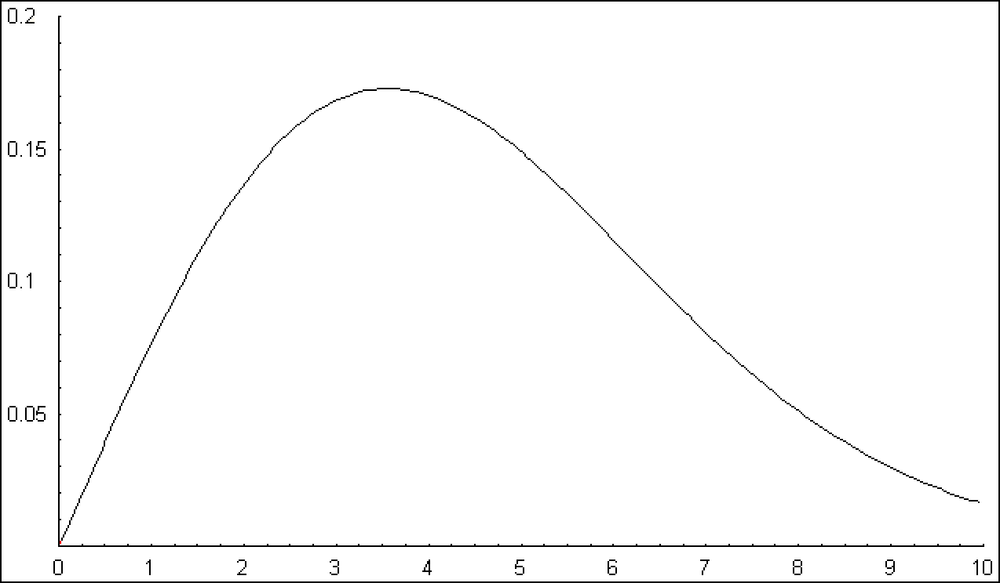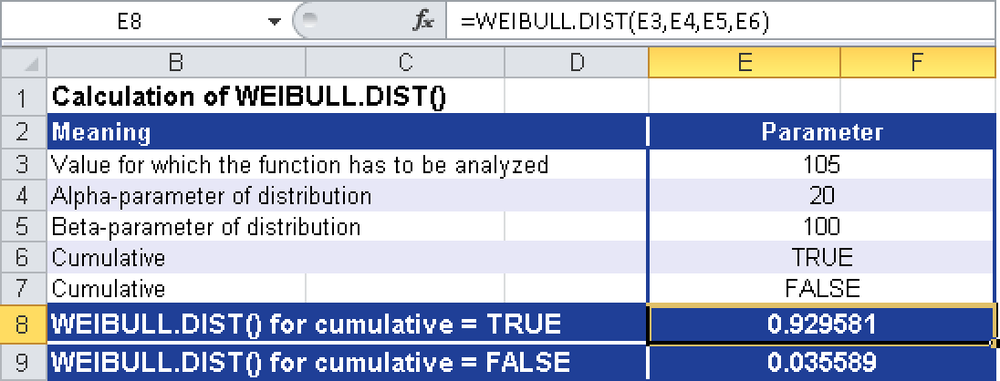Syntax. WEIBULL.DIST(x;alpha;beta;cumulative)
Definition. This function returns the probabilities of a Weibull-distributed random variable. Use this distribution in a reliability analysis (for example, to calculate a device’s mean time to failure).
Arguments
x (required). The value at which to evaluate the function.
alpha (required). A parameter of the distribution.
beta (required). A parameter of the distribution.
cumulative (required). The logical value that represents the type of the function. If cumulative is TRUE, then WEIBULL.DIST() returns the value of the distribution function that is the probability that the number of random events is between 0 and x. If cumulative is FALSE, the WEIBULL.DIST() function returns the value of the density function.
Note
If x, alpha, or beta isn’t a numeric expression, the WEIBULL.DIST() function returns the #VALUE! error.
If x is less than 0, the function returns the #NUM! error.
If alpha or beta is less than or equal to 0, the WEIBULL.DIST() function returns the #NUM! error.
Background. The Weibull distribution is also a statistical distribution. Among other things, the Weibull distribution is used to examine the life cycle of devices based on the fatigue of brittle material or the mean time to failure of electronic parts.
The Weibull distribution is named after Waloddi Weibull (1887–1979). The Weibull analysis is considered a classic reliability analysis or classic life cycle chart and is commonly used in the auto industry. The so called “Weibull net” shows the typical life cycle and the failure probability for parts and other components.
In general, a Weibull distribution is an exponential distribution. The Weibull distribution is used for different purposes:
Many distribution forms can be defined with the Weibull distribution.
The Weibull function is easy to calculate.
Time-dependent failure methods are displayed as straight lines.
See Also
You will find more information about exponential distributions in the description of EXPON.DIST().
The WEIBULL.DIST() function calculates the density and the distribution function of the Weibull distribution.
To calculate the density function, specify the logical value FALSE for the cumulative argument. The density function is the first derivation of the distribution function based on a random variable (such as the time for the failure density function). In other words, the differential change of the relative frequency per scale unit is calculated.
To calculate the distribution function, specify the logical value TRUE for the cumulative argument. The distribution function F(x) indicates the relative cumulative frequency of events.
The distribution function F(x) indicates the probability that the random variable y doesn’t exceed value x (see Figure 12-154).
Figure 12-154. A Weibull distribution with the arguments x, alpha=5, beta=2, and cumulative = FALSE.
The equation for the distribution function of a Weibull distribution is:
F(x, α, β) = 1 – e–(x/β)α
The equation for the density function of a Weibull distribution is:
If alpha = 1, WEIBULL.DIST() returns the exponential distribution with:
The failure ratio depends on the parameter β:
1 > β means that the rate is monotonically increasing.
1 = β means that it is consistent and is an exponential distribution.
1 < β means that the rate is monotonically decreasing.
Example. Use the following values to calculate WEIBULL.DIST():
105 = the value at which to evaluate the function (x)
20 = alpha parameter of the distribution (alpha)
100 = beta parameter of the distribution (beta)
TRUE = cumulative
FALSE = cumulative
Figure 12-155 shows the calculation of WEIBULL.DIST().
The WEIBULL.DIST() function returns the following results using the parameters shown in Figure 12-155:
For cumulative = TRUE, the WEIBULL.DIST() function returns the distribution function of a Weibull distribution with the value 0.929581.
For cumulative = FALSE, the WEIBULL.DIST() function returns the density function of a Weibull distribution with the value 0.035589.




